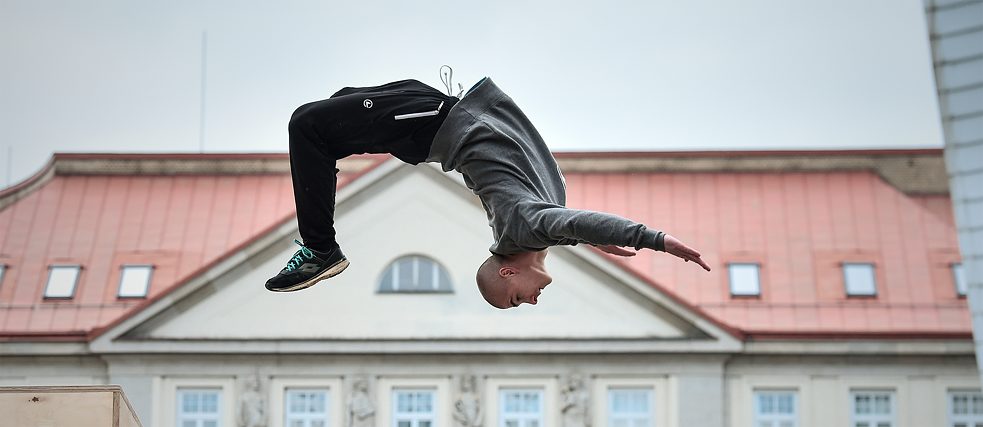Cultural heritage
Heritage Parkour

Imagine climbing to the top of the Acropolis, running along the flanks of the sphinx or balancing on the gable of Cologne Cathedral. Parkour as cultural mediation is the focus of a pilot project.
By Nadine Bergmann
They are a familiar sight in any town or city with a cultural profile: groups of tourists gazing with varying degrees of interest at a monument or historical building, listening to a local guide delivering a well-rehearsed speech on the place’s history and cultural significance. Guided tours are a totally passive form of cultural mediation. And even if the guide tries to lighten up his delivery, the sheer volume of facts and figures means that many a person’s visit to a major heritage site is marked by awe and detachment. The fact that most historical buildings are only viewed and not experienced makes them lifeless and unapproachable for lots of people. This is a source of concern for cultural heritage experts. Critics warn of the so-called ‘museumisation effect’, which intensifies with the status of the building. The more famous it is, the less approachable it becomes.
But what if historical buildings could be explored and experienced physically? In summer 2018, a group of traceurs tried to do just that. Traceurs are practitioners of parkour, who ignore beaten tracks and create their own routes through urban and natural environments. Obstacles like fences and walls are overcome using practised climbing and vaulting techniques, walls and railings require balancing acts. In Berlin, these skills were used to scale the memorial to Polish soldiers and German anti-fascists in Friedrichshain: traceurs hauled themselves up stone figures and vaulted over flowerbeds. It was undoubtedly the first time the monument had been experienced like that.
The freedom to use historical places in a different way
The heritage traceurs in Berlin were Parkour novices and participants in a project jointly undertaken by Goethe-Institut and the ParkourONE Academy, a parkour school with branches in Germany and Switzerland. Goethe-Institut wants to find new ways to enable people to discover and appreciate cultural heritage and historical buildings – the four-hour workshop “Parkour and cultural heritage! How can parkour raise awareness for cultural heritage?” was a pilot project.
Getting physically so close to the cultural monument was new even for the experienced traceurs. “You start out with a very real sense of respect, and you never really lose it,” one participant told the interviewer. Another said they had taken the liberty “to use the site in a different way today and, by doing so, learn to appreciate it.” That is entirely in line with the spirit of the message on the memorial: “For your and our freedom”.
“The TRuST concept of parkour – where parkour serves as an educational tool – opens a door to active, constructive engagement with cultural heritage,” explains Martin Gessinger, deputy head of the ParkourONE Academy. “The site is not treated as an exalted glass-domed temple, we literally get to grips with it and its surroundings. A cultural site is often just looked at, maybe talked about a bit, but that is about all. Many people simply do not engage with it.” Parkour, on the other hand, is an unconventional form of cultural mediation: practitioners discover the different materials used in construction and their textures, which makes for a deeper awareness overall. “It is a conscious engagement with social, historical and cultural space – with respect and caution always paramount.”
Is it allowed to climb on historical statues?
There is a reason that Parkour is not widely practised at cultural sites. Not every building or structure is suitable. Access to some needs to be restricted in order to preserve them. And then there is the question of sufficiently respectful treatment of cultural heritage. Where do you draw the line?
“Is it disrespectful to practise parkour or is it actually a sign of respect, because I am actively focused on the place?” Gessinger thinks there can be no hard and fast rule about whether it is acceptable to use a cultural site for parkour. Each case needs to be discussed and judged on its merits. Among the values that ParkourONE holds dear is respect for the environment and commitment to its sanctity. Workshop participants learn this at the outset. But they are also taught to be aware of cultural issues: “In this workshop we specifically look at the way a site is used. Why was it built? What did it signify? What does it signify today?” In the case of the memorial to Polish soldiers and German anti-fascists, the decision was easy: the place is also popular with skaters and used on a daily basis anyway.
Infobox: Parkour
Parkour practitioners – called traceurs – have found a new way to explore their surroundings: they ignore the paths defined by architects and planners and seek new routes through the urban jungle using features of the environment as tools. Parkour was born in the early 1990s in the suburbs of Paris, developed by Frenchman David Belle and his group of friends. What began as a kind of obstacle race evolved into a – largely urban – discipline where fences, walls and even facades are part of the challenge. Today, nearly every city has active traceurs, interacting with their surroundings in a novel way.
Comments
Comment